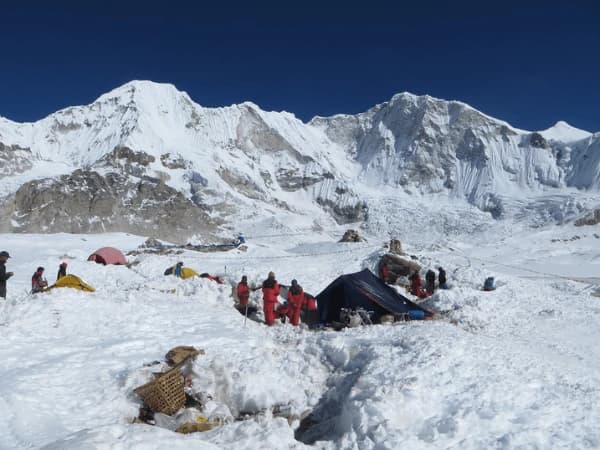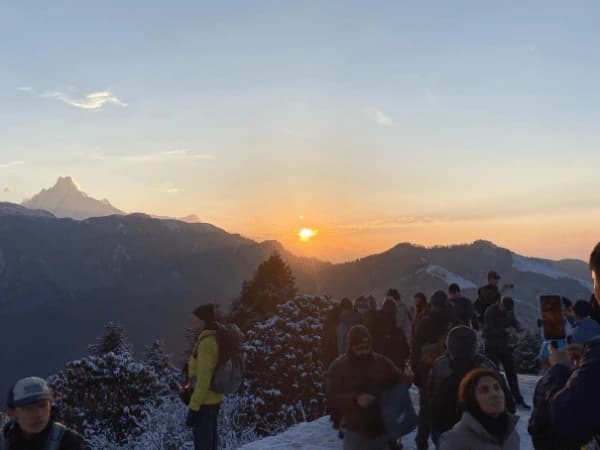would you rather go to Manaslu Circuit OR Annapurna Circuit if there is Himalayas Manaslu Circuit vs Annapurna Circuit Trek in Nepal? Comprehensive Trekking Guide by Overland Trek Nepal In the world, where trekking in Nepal is concerned, Manaslu Circuit Trek and Annapurna Circuit Trek have it all. The two routes Himalayas Manaslu Circuit VS Annapurna Circuit Trek in Nepal combine together a unique Himalayan experience of rough terrain, vibrant cultures and spectacular views. Nevertheless, each circuit has its own style of trekking and will be more comfortable for specific type of trekkers.
We Maximum Manaslu and Annapurna Circuit Trek combines a complete look at two of Nepal’s famous trekking destinations: the Manaslu trek into remote western areas including the restricted area known as Tsum Valley, plus an extended trek around the entire Annapurna Massif that offers diversity in culture with stunning scenery on this Himalaya mountain range. So Travelers use to compared Himalayas Manaslu Circuit vs Annapurna Circuit Trek in Nepal
Manaslu Circuit Trek: A brief Introduction
Manaslu Circuit Trek: The Manaslu Circuit Trek goes around Mount Manaslu (8,163 m) the 8th highest peak on the planet. All in all, this trek is one of the up-and-coming treks which can be described as one of the best off-the-beaten-path treks in Nepal that it may be gradually gaining grounds but still retains its unspoiled beauty. A relatively less trekked route compared to popular routes like the Annapurna Circuit, although it has offered a remote and wilderness experience since trekking opened here in 1991.
Highlights of Manaslu circuit
- Max Altitude: 5,160 meters at Larkya La Pass
- Duration: 14–18 days
- Location: Manaslu Conservation Area, north central Nepal
- Peak Season: March–May & September-November
- Permits: RAP, MCAP, ACAP permit
- Lodging: Simple teahouses and lodges
This is the only alternative circuit which has remoteness and unspoiled landscape away from crowds, less number of trekkers around Gongma,and Dah to Lato complex trail combined with deep cultural insight in the Buddhist villages.
Annapurna Circuit Trek Summary
Annapurna Circuit Trek Itinerary One of the classic treks in Nepal, Annapurna Circuit Trek weaves through various landscapes and cultures to offer you an unparalleled opportunity to see the Annapurna Massif up-close. Adventurers from all corners of the globe have been hitting this must-do trek, which opened to the public in the late 1970s. The Annapurna Circuit is a bit of a fuller trekking experience, with more hotels/teahouses (though not teahouse), lovely marked tracks and so on.
Best Feature Of The Annapurna Circuit
- Highest Altitude: 5,416 meters on Thorong La pass.
- Time: 12 -21 days (as per point of origin)
- Location: North Central Nepal and along Head of Kali Gandaki River
- Top Season: March–May & September–November
- Permits: To trek in Annapurna region, you will need an Annapurna Conservation Area Permit (ACAP) and a TIMS card (Trekker’s Information Management System)
- Accommodation: including tea houses, lodges and hotels
- Trade Mark: The diversity of Austrian landscapes, great trail quality, cultural richness and accessibility.
- Route and Scenery Comparison
Manaslu Circuit Trek Itinerary and Landscapes
Manaslu CircuitOne of the most remote and unspoiled areas of Nepal, the Manaslu circuit both challenges and entices alike. The trek starts at Soti Khola passing through the lush subtropical forests, cascading rivers and terraced fields. Alos, It transforms to more rugged and alpine terrain. Moving a bit higher up you cross several Tibetan influenced villages namely Sama Gaon and Samdo which will provide local cultural exposure. The trek reaches its apex at the breathtaking Larkya La Pass (5,160 meters), offering hikers stunning views of Himalchuli, Ngadi Chuli, and Manaslu in all her glory.
Manaslu lies in a more remote area, which is why the region has less footfall. It is wherever wild and civilization dwell facet through side altogether their glory, also a paradise of Buddhist monasteries that area unit many years previous creating its place on the hills. There is a range of scenery, from plunging ravines and cascades to glacial moraines so the visual stimulation covers quite a width.
Annapurna Circuit Trek Route and Landscape
By contrast, the Annapurna Circuit is a feast of landscapes packed into one trek. The journey usually starts in Besisahar or Chamje – it meanders through terraced fields, thick forests, and riverside hamlets. While on the trek, you will also make your way up from the Marsyangdi Valley — showcasing a wonderful assortment of subtropical forests, alpine meadows and high-desert scenery reminiscent of Tibetan plateaus.
The cultural diversity you will come across during the Annapurna Circuit is amazing, including villages populated by Gurung, Thakali and Tibetan Buddhist inhabitants. The end of the trek is Thorong La Pass (5,416 meters) from where you get a full view of the Annapurna as well as Dhaulagiri range which includes peaks such as Annapurna I (8,091 meters), Trail provides.
In conclusion, although the Manaslu Circuit gives you more isolation and a pure Himalayan experience, the only one of its kind in Nepal but with Annapurna Circuit also wins over for most diversified environment as well as culture.
Difficulty Level
Manaslu Circuit Difficulty
The Manaslu Circuit is typically more difficult as it is more remote and there are less amenities. This trek includes many days of hiking on difficult and steep terrain. The Larkya La Pass route is challenging due to altitude and snow, especially off-season, requiring a permit and guide for entry.
Since the altitude ascends pretty fast, acclimatization is key the Manaslu Circuit. Given the high altitude, long trekking days and rugged paths, it is not a technical climbing challenge, but for experienced trekkers.
Annapurna Circuit Difficulty
For modern facilities and fewer shortages of food or lodging, the Annapurna Circuit is better developed but remains challenging, especially crossing the 5,416m Thorong La Pass. Altitude sickness can be an issue if trekkers go up too fast during acclimatization process.
Itinerary-Friendly: The Annapurna Circuit is an itinerary where you can choose to cut or expand the trek according to your ability and level of fitness. The average trekker can take on this trek, even without high-altitude experience, as it isn’t too technical. However, personal physical preparedness is important due to the altitude.
Cultural Experience
Manaslu Circuit Culture
While having lunch on the Manaslu Circuit, trekkers experience the strong Tibetan-Buddhist culture that surrounds them throughout the journey. As you approach Sama Gaon (home to many resident foreigners) and Samdo, you’ll notice a fresh cultural flavor. Along the way, you’ll also encounter beautiful monasteries, prayer wheels, and mani walls, offering a deeply spiritual experience. Without a lot of trekkers coming through this region, the local influence is still strong and it provides more authentic cultural experience.
You will meet individuals from the Tibetan-origin Nubri and Tsum communities, whose traditional ways of life have remained pretty much unaltered for centuries. The Tibetan Influence is present in the architecture as well as festivals and customs, offering a never seen before insight into this ancient civilisation.
Annapurna Circuit Culture
The Annapurna Circuit is rich in culture, composed of a mix of Gurung, Magar, Thakali and Tibetan Buddhist culture. On the way, you will cross Gurung villages like Chame and Thakali villages of Jomsom, Marpha and each village in Annapurna has its unique culture, traditions, festivals.
As one of the most popular, the Annapurna Circuit goes through commercialised parts with a cultural blend between locals and trekking tourism. Yet, the cultural tapestry is so rich that it provides a truly deep window on to Nepal itself. You will visit Buddhist monasteries, Hindu shrines, and experience the typical Thakali hospitality.
Accommodation and Food
Lodge and restaurant on the Manaslu Circuit
Compared to the Annapurna Circuit accommodation on the Manaslu Circuit is more basic. The route has some teahouses that offer an overnight stay with basic room only. The amenities in more remote areas are not always available, hot showers, Wi-Fi and electricity at higher altitudes.
The Manaslu Circuit mainly offers Nepali food like dal bhat, noodles, and potatoes, providing filling, nutritious meals.
Food and Accommodation along Annapurna Circuit
Both the sleeping options are teahouse, but on the Annapurna Circuit there is a wider range of choice from basic to a little more comfort. Hot showers, Wi-Fi and Western-style food are available in guesthouses of Manang and Muktinath but for the most part, accommodation very basic.
The Annapurna Circuit offers a greater variety of food. You can enjoy another serving of dal bhat, along with pizzas, pastas, and even apple pie in villages like Marpha, which is famous for its apples. The Annapurna Circuit consists of a more diverse choice of food and accommodation offers a blend of adventure and comfort — perfect for trekkers who like the best of both worlds.
Permit and Logistics
Manaslu Circuit Permits
Special permits are required for the Manaslu Circuit as it has restricted status:
Restricted Area Permit (RAP):Need to acquire with the assistance of tour operators like Overland Trek Nepal.Manaslu restricted zone permit (RAP)
Objective: Manaslu region is a controlled hiking zone that necessitates special permits for the locals. The RAP is to control trekking in the area, and protect it’s cultural and environmental integrity.
Cost:
September – November $100 for first 7 days, then $15 per day thereafter
Jan 1 – Jul 31: $75 for the first week, and then $10 per day thereafter.
How to Get It: You must register for the permit with a registered trekking agency (like Overland Trek Nepal) and are required to trek with a licensed guide. It is unattainable on its own.
Note Trekking alone is illegal thus there must be two trekkers to apply for the permits.
Manaslu Conservation Area Permit (MCAP) Fee
Manaslu Conservation Area Entry Permit: This is required to get into the Manaslu CA Canon which exists in order to conserve the biodiversity and setting of the field.
Cost: NPR 3000 for foreigners and NPR 200 for SAARC nationals
Where to Find It: From Nepal Tourism Board office in Kathmandu or Pokhara; or a trekking agency.
3. Annapurna Conservation Entry Permit (ACAP)
This permit is also needed to pass through the Annapurna section of the trek as it goes into the Annapurna Conservation Area.
Temperature: NPR 3,000 (approx USD 25) for foreigners, NPR 200 SAARC nationals.
How to Get It: The ACAP permit can be obtained from the Nepal Tourism Board in Kathmandu or Pokhara and also at the Trekking Agencies.
Permit Notes
Trekkers must carry their non-transferable permits throughout the trek, as officials will inspect them at various checkpoints. Since Manaslu is a restricted trekking area, all trekkers must hire a licensed guide, and solo trekking is NOT allowed. These permits protect the Manaslu region’s cultural and natural heritage while ensuring trekkers’ safety during the journey.
Annapurna Circuit Permits
Anapurna Conservation Area Permit (ACAP)
Why: The Annapurna Conservation Area Permit is essential to visit the lands in this place that help conservation of natural resources and at the same time boost sustaiable tourism.
Cost:
Others: NPR 3,000 (approx USD 25)
SAARC Nationals: NPR 200 (Approximately USD $2)
Where To Get It: In either Kathmandu or Pokhara from the Tourism Board Office.
2. Trekker’s Information Management system (TIMS) Card
Purpose: Safety and security of trekkers are to be induced from TIMS card. This device enables authorities to determine the location of trekkers and to recover them in case there is an emergency.
Cost:
Solo: 2,000 NPR (approx. 17 USD)
Group trekkers pay NPR 1,000, while others pay NPR 800. Khadga Bahadur Bishwokarma encountered crude police behavior, revealing corruption.
You can find it at the Trekking Agencies’ Association of Nepal (TAAN) offices in Kathmandu, Pokhara, or the Nepal Tourism Board.
Permit Notes
Take both the permits with you all the time while on trek. It will be checked at a number of checkpoints.
Permits: These are non-transferable and need to be acquired prior to the start of the trek.
You need a licensed guide and should be with a group of at least




